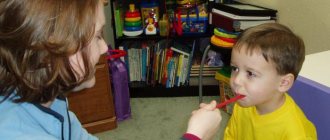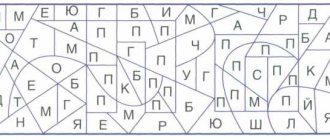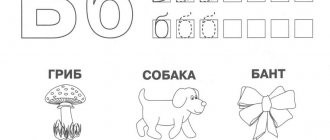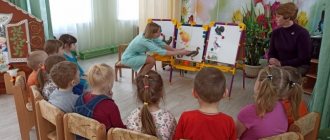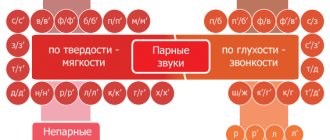Exercises to form the letter “r”
Exercises for the letter r for children should be done daily, preferably in a playful way. It would be best to conduct classes in the morning and evening and be sure to sit in front of a mirror so that the baby can see the work of his lips. First, the parent shows by example how to pronounce the letters correctly, then the child repeats. All lessons are conducted in a friendly atmosphere; no shouting or scandals are allowed in order to avoid a negative experience.
Preparation of the speech apparatus
There are many nuances when working with exercises to pronounce the letter r for children. And, of course, you should initially prepare your speech apparatus for work. The beginning of training is articulation gymnastics.
Preparing for further work on pronunciation
Note! Exercises are always done in front of a mirror with the baby. This makes it easier for him to repeat after his parents. Perform training daily, repeating each exercise 6-8 times. Remember that a child’s nervous system is formed before the age of ten, therefore, at the first signs of fatigue and irritation, it is worth taking a short break.
Gymnastics has the following goals:
- Develop tongue mobility. Various exercises are done to make the tongue wide, narrow, raise and lower it, touch the cheeks in turn.
- Develop lip mobility. Exercises “Clown”, “Piglet”, “Monkey”.
- Develop the skill of holding the lower jaw in a certain position. The child tries to push it forward and fix it and back.
Forming a sound culture of speech: speech corner and tongue twisters
Difficulty pronouncing "r"
Why the letter causes difficulties:
- It is often found between vowels in words.
- It is difficult for a child to pronounce it correctly, he replaces it with “l”, “s”, “th”, because he does not have the correct pronunciation skill,
- The baby cannot pronounce the sound firmly enough; grazing occurs (like the French language) or strong vibration (burring).
- The pronunciation is "on the nose". This happens because the baby does not know where the tip of the tongue should be when pronouncing.
Tongue muscle training
In exercises for the sound p for children, there is always a warm-up of the tongue:
Language exercises from speech therapy
- "Swing". Open your mouth wide, raise and lower your tongue up and down, touching your teeth and holding in one position for 20 seconds.
- Lick your lips with your tongue clockwise and vice versa.
- "Painter". The mouth is closed, the tongue inside is moving along the palate, cheeks and teeth.
- "Horse". The child clicks his tongue, imitating a horse.
- "Elephant". Pull your lips forward, draw in air as if an elephant is taking in water, then release the air as you exhale.
A set of exercises for stretching the frenulum of the tongue
Speech therapy classes on the letter r are often accompanied by exercises to stretch the frenulum of the tongue, since problems with pronouncing sounds may lie precisely in the short frenulum.
Exercises are always performed slowly:
- Open your mouth wide, leaving it motionless. The tongue moves across the palate from the teeth to the throat.
- "Football". Opening his mouth, the baby touches the right and left cheeks in turn, strongly straining the tip of his tongue.
- "Kitty". This is the most favorite exercise among children. Pour your favorite treat onto a saucer and ask him to lick it off with his tongue.
- "Harmonic". Press your tongue firmly against the roof of your mouth. Then open and close your mouth, while your tongue remains motionless.
Exercises to stretch the frenulum of the tongue
A set of exercises that develop the speech apparatus
When developing your speech apparatus, you should remember about breathing.
Breathing exercises:
- Inhale and then try to “blow out the candle” by exhaling lightly.
- "Birthday Cake" Inhale, and as you exhale try to blow out as many imaginary candles as possible. You can't get air.
- After inhaling, as you exhale, say: “what a fragrant flower.”
- After inhaling, as you exhale, pronounce the sound “sss”, and then switch to “rrr”.
- As you exhale, imitate the sound of the wind - the sound “vvv”.
- As you exhale, imitate a samovar - “puff-puff-puff.”
- As you exhale, say tongue twisters.
You can also use passive gymnastics to warm up. Children especially enjoy working in pairs with siblings or a parent.
Passive articulatory gymnastics
Making the sound “r” with children
The most important step in speech therapy exercises for the letter p is sound production. It is divided into three stages:
- Learn to pronounce confidently the sound separately.
- Add pronunciation of syllables, words,
- Only then start making sentences and tongue twisters.
Sound production technique
The placement of the letter “r” is divided into the placement of the letters “r” and “r”. First you need to learn how to pronounce the hard “r” successfully. For these purposes, all the exercises described above are performed.
The production of the soft “r” occurs due to the pronunciation of pure phrases. You can come up with them yourself or use the following:
- There is an oak tree on the mountain - re-re-re,
- And on the branch there are bullfinches - ri-ri-ri,
- And the mower’s scythe - rya-rya-rya,
- I tell everyone the truth - ryu-ryu-ryu.
A device that helps formulate the letter r
To complicate the task, you can use special devices or sticks that the child will hold with his lips.
Speech development in the younger group - norms for children's speech development by spring
Tasks for developing correct pronunciation
7 tasks for correct pronunciation of the letter “r”:
- "Cuckoo-clock". The baby with his mouth wide open stretches his tongue to the upper lip, then by the teeth to the tubercles.
- "Tremors." The baby learns to shake his tongue by releasing air as he exhales and touching his lips with his tongue.
- "Face." While smiling widely, you should bite the tip of your tongue.
- "Horse". Imitating the clicking of a horse.
- "Drummer". Open your mouth wide and try to say “d.” Then the child will touch the alveoli and understand the correct position of the tongue when pronouncing “r”.
- "Toothbrush". “Brush” your teeth with your tongue from the inside of your teeth.
- "Sucker". “Glue” your tongue to the roof of your mouth, hold it tightly, open and close your mouth without removing your tongue.
Articulation development
Articulation development should take time. It will help train exhalation, stretch the frenulum of the tongue and strengthen it in the upper position.
It is very important that the baby learns to exhale powerfully. Soap bubbles will help him with this. It's both exciting and useful at the same time. You can also use a ping-pong ball - the child should be able to drive it into the gate. This will form the correct air stream when exhaling.
Exercises for articulation are similar to those used in articulation gymnastics.
Consolidate the result
It is important not only to teach the child the correct pronunciation skill, but also to consolidate the result after fruitful work.
Audio Automation Exercises
The last stage in speech therapy classes on the sound p is considered to be automation of sound.
It includes several exercises that are carried out in a playful way:
- Using cards with words with the letter “r” written on them. If you pronounce it incorrectly, say the correct word, then remove the card. Next time, when the letter is pronounced correctly, praise the child and replace the card with a new one.
- "Remember the order." The same cards are used. 5 of them are laid out in a row, the baby remembers their sequence. Then he turns away and tries to say the words in the order in which they were written.
- Poems. It is advisable to learn them by heart immediately and pronounce them as often as possible while walking.
Tongue Twisters
In speech therapy tasks with the letter r, tongue twisters are often used:
- “Karl stole corals from Clara, and Clara stole Karl’s clarinet,”
- “There is grass in the yard, there is firewood on the grass, don’t cut wood on the grass in the yard,”
- “The crow missed the little crow.”
Additional Information! Constantly listening to and repeating tongue twisters by your child is a gentle training of his attentiveness. He acquires the skill of listening. This has a beneficial effect on the further education of the preschooler, where he will have to learn a much larger amount of information.
When do you need help from a speech therapist?
The help of a speech therapist may be needed when:
- A 4-5 year old child pronounces sounds unclearly,
- Speaks softly, indistinctly, “swallows” sounds,
- At 6 years old does not pronounce sounds correctly,
- Speaks with hesitation, cannot answer questions, rearranges and confuses syllables.
Activities with your child will be exciting and educational for both him and the adult. The most important thing is to show attentiveness and patience, learn to hear the child and help him overcome difficulties.
